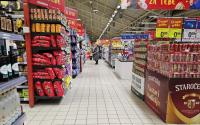8 March 2005Thestar OnlineCharles J. Hanley
As the light plane banked left, the smell of smoke reached the cockpit. The landscape below was an ashen green, the sun above an orange glow behind sooty billows of grey.
The Amazon forest was burning, and it was more than a sign of human encroachment. It was also the sight and scent of a dangerous chemistry, of tonnes of carbon dioxide – transformed from wood and leaf – rising into an atmosphere already loaded with it.
In cooler confines some days later, at an international climate conference in Argentina, British scientists told of a different, slow-motion kind of chemistry in the tropical forest, one foreseen by supercomputers running intricately programmed models of global warming.
"In the Amazon, the vegetation dies back because there won't be enough rain,'' explained climatologist Vicky Pope, detailing one of the most sophisticated studies yet – by Britain's Hadley Centre – of what a warmer world would mean.
 |
Scientists are studying the effects of low rainfall on the Amazon at the Tapajos National Forest Reserve. |
Whether it unfolds quickly by fire or slowly through global warming, the future of this forested river basin is a key to the future of Earth's climate. Hundreds of scientists are working overtime to understand that critical relationship – between the atmosphere and the region known as Amazonia, more than 11 times the size of France and home to one-third of the world's species.
"Scientifically, we're not 100% confident we know all the processes,'' said Brazilian physicist Paulo Artaxo, who has studied the Amazon for 20 years. "There are thousands of different critical effects. There's much more scientific work that needs to be done.''
Artaxo is a lead scientist among 1,700 researchers, from 200 universities and other institutions, who have joined during the past six years in an unprecedented undertaking called LBA – for Large-Scale Biosphere-Atmosphere Experiment in Amazonia – a Brazilian-U.S.-European scientific assault on the unknowns of what some call the planet's "lung,'' the Amazon's breathing green vastness.
The respiratory process is well known: Trees absorb carbon dioxide through their leaves, use it to build themselves, and emit oxygen into the air. That keeps an atmospheric balance, but industrialised man has thrown the balance off by burning fossil fuels and producing excess carbon dioxide, which traps heat that otherwise would escape into space.
Scientists believe the 0.6°C rise in global temperatures over the past century was largely a result of those emissions, and they project higher temperatures and climate disruptions to come. The international pact called the Kyoto Protocol, a limited first step in trying to control emissions, took effect on Feb 16, though without participation of the United States, the biggest emitter; it maintains the emissions cutbacks would set back its economy too much.
The forest's basic science may be well known. But the details are immensely complex – of soils and nutrients, evaporation and precipitation, rivers and lakes, gas flows and root systems, and of the hard numbers of deforestation, which pours carbon dioxide into the atmosphere at the same time that it kills off carbon-absorbing vegetation.
But whatever the unknowns, "we already know enough to make policy decisions. The important thing is to stop deforestation,'' said American ecologist Philip M. Fearnside.
Satellite reconnaissance showed that 600 fires were started in the Amazon region each day on average last year, the Brazilian government reports. The rate of destruction has almost doubled in the past decade, to 23,400sqkm over 12 months of 2003-2004 – an area about the size of Belgium.
 |
A Brazilian girl walking through a patch of Amazon jungle that was recently burned to plant corn, near the town of Anapu, Para. |
The government's own plans to pave 3,360km of additional road through the wilderness could lead to clearing of up to 182,000 sqkm of forest over 30 years, it was estimated by Fearnside's Amazon Environmental Research Institute. Judging from experience, "paving increases the deforestation rate in a strip along the highway, to a depth of 50km on each side,'' said Fearnside.
What might this mean in a time of climate change?
Worldwide deforestation is now believed to contribute under 20% of manmade emissions of carbon dioxide, said Artaxo, of Brazil's University of Sao Paulo. And the Amazon forest is believed to remain a "sink'' still absorbing slightly more carbon than it emits.
But scientists say the feedback loops of a warming world might change that picture in mere decades.
For one thing, computer modeling foresees a warmer Pacific Ocean stirring more frequent and intense El Ninos, the climate phenomenon that tends to dry the eastern Amazon. Rising temperatures themselves would also help dry vegetation. In addition, deforested terrain sends less moisture – via plants' "evapotranspiration'' – into the air to fall as rain. Dead trees then add more carbon dioxide to the atmosphere, further heightening warming in a destructive cycle.
The Intergovernmental Panel on Climate Change, a United Nations-organised science network, concluded in its latest assessment that the remaining Amazon "is threatened by the combination of human disturbance, increases in fire frequency and scale, and decreased precipitation from evapotranspiration loss, global warming, and El Nino.''
Much more remains to be learned, even including how much "biomass'' an average hectare contains in this highly diverse forest – a number crucial to knowing how much carbon a dying forest would release.
The NASA orbiter ICESat has been working on that. Designed to monitor melting polar icecaps, the satellite's sensitive laser eye was turned to measuring tree heights in the Amazon to help scientists judge how much wood is down there.
 |
Deforestation near the city of Santeram in the Brazilian state of Para. Worldwide deforestation is now believed to contribute under 20% of manmade emissions of carbon dioxide. |
In one of their most elaborate experiments, they have produced a vision of a bleak, dry future 50km south of Santeram, on a patch of the Tapajos National Forest, a shadowy green world of barking monkeys, iridescent butterflies and whistling Captain-of-the-Woods birds, and of ropey vines hanging from hundreds of tree species.
At this Seca Floresta site – "Dry Forest'' – scientists for four years have deprived 1ha of Amazonia of half its normal rain by stretching a plastic roof of 5,600 polyethylene panels over the soil.
Towers, catwalks and instrumentation allowed researchers to closely monitor tree metabolism and respiration, groundwater and gas flows and other processes as this piece of forest succumbed to what the computer models foretell for much of the Amazon.
"We got some amazing results,'' research manager Paulo Brando said. "We expected the smaller trees to die more. But it was the larger trees. They're dying at a rate of 9% a year'' – several times the natural rate."
At treetop level, from a 27m tower, leafless, desiccated spots could be seen in the canopy. Carpets of leaves and fallen limbs littered the forest floor.
"If you have large trees dying, you have a lot of carbon being released,'' Brando said.
If they're dying across great stretches of Amazon, in the "dieback'' of the supercomputers, these scientists say, the cost to the world could be incalculable. – AP






